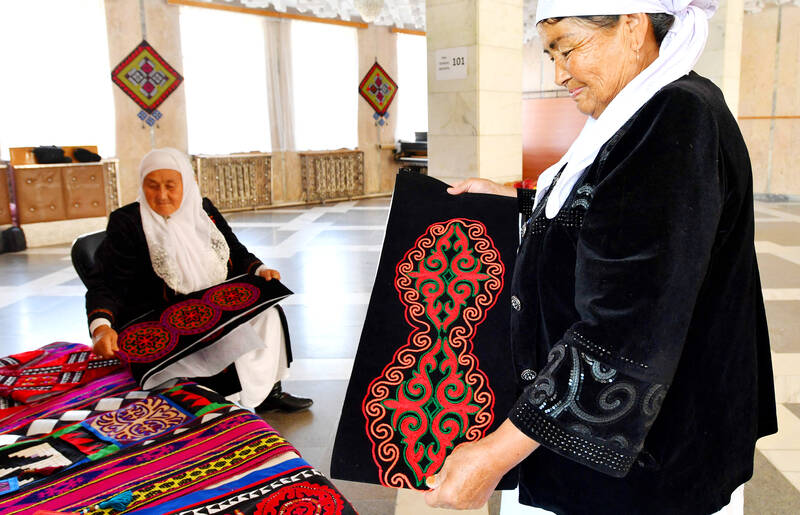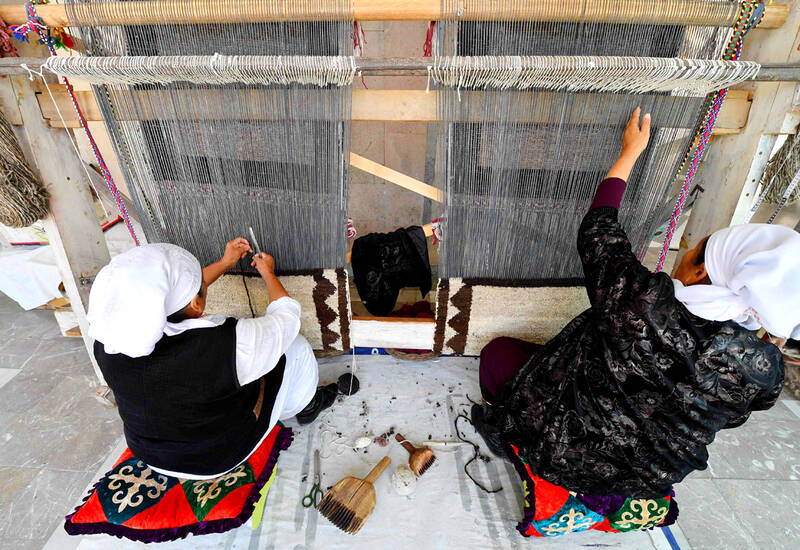Tashkan Khakimova, 77, crouched over a wooden weaving machine, wool speeding through her fingers, using a traditional rug-making technique in Kyrgyzstan’s remote mountainous region of Batken.
A young schoolgirl held the remaining wool next to Khakimova, dressed in a white headscarf and a velvet jacket with traditional embroidery on it. After several hundred hours of work, the wool will be transformed into a shyrdak: a traditional Kyrgyz rug.
Khakimova is one of a shrinking number of mostly elderly people living in the Central Asian country’s mountainous areas who know how to make a shyrdak. Many worry the ancient art will die out.

Photo: AFP
“Our parents taught us the technique, but people are forgetting it,” Khakimova said. She is part of a group of older women calling themselves the “Happy Grandmas” who meet in the small town of Kadamjay. nestled between the Alay mountains, to preserve the endangered craft and boost their meager pensions.
UNESCO has warned that the skill of making the unique rugs is “in need of urgent safeguarding,” with an abundance of synthetic carpets and the young being mostly disinterested.
The “Happy Grandmas” have a mission: to attract Kadamjay’s youngsters to learn the ancient technique. The group of around 20 women meet several times a week in the local Soviet-era house of culture, encouraging school children to learn how to weave.

Photo: AFP
“We come here so that this craft can be passed on from generation to generation, to teach it to young people,” Khakimova said.
Rakhat Dzhoroyeva, another woman in the group, said it was important to preserve the rugs as “these are customs that we inherited from our ancestors.”
“We don’t want to sit at home with our arms crossed,” she said. “We decided to continue the tradition.”
The women use wool from their own animals to make the rugs.
“Production costs nothing,” Dzhoroyeva said, adding that wool is collected from cattle, sheep and goats and “nothing goes to waste.”
She energetically lifts threads with a comb to strengthen the knots of the brown carpet she is making. The shyrdak will then be decorated with colorful traditional patterns recalling the nomadic culture of the Kyrgyz people, before being cut out and quilted to make it more resistant.
The pensioners meet at the “House of Culture of the Metallurgists” of Kadamjay — a city built in the 1930s around a huge metals factory that is now shut down. Hoping to “attract the young,” the women take center stage in the building, with their traditional singing reverberating around the marble hall.
Curious schoolgirls walk past, with a six-year-old soon crouching down to examine the work done by the retirees.
Living in Kyrgyzstan’s poorest region, the “Happy Grandmas” also hope selling the home-made rugs will boost their pensions.
“I get around 6,000 som in pension (around US$67 a month),” Saliya Bozhoyeva, another woman in the group, said. “We can sell rugs for several hundred euros, it allows me to compensate (for) my pension.”
The rusty, abandoned metals factory — which used to employ many of the women — towers over Kadamjay. Its bankruptcy has led to unemployment and an exodus of the working population.
“My husband and I used to work at the factory, but today young people are forced to look elsewhere,” Khakimova said.
Like many families in Kyrgyzstan, her children have gone to Russia — a traditional place of employment for Central Asians — to look for work.
But the “Happy Grandmas” have some hope: there has been a renewed interest in traditional Kyrgyz carpets. Easing tensions with neighboring Uzbekistan have raised the possibility of attracting tourists to this remote region and the chance to strengthen the local economy — with some orders even coming from abroad.
“We have a lot of orders, mainly from Bishkek,” Dzhoroyeva said.
She added, joyfully: “And soon, we will send a rug to Japan.”

Most heroes are remembered for the battles they fought. Taiwan’s Black Bat Squadron is remembered for flying into Chinese airspace 838 times between 1953 and 1967, and for the 148 men whose sacrifice bought the intelligence that kept Taiwan secure. Two-thirds of the squadron died carrying out missions most people wouldn’t learn about for another 40 years. The squadron lost 15 aircraft and 148 crew members over those 14 years, making it the deadliest unit in Taiwan’s military history by casualty rate. They flew at night, often at low altitudes, straight into some of the most heavily defended airspace in Asia.

Beijing’s ironic, abusive tantrums aimed at Japan since Japanese Prime Minister Sanae Takaichi publicly stated that a Taiwan contingency would be an existential crisis for Japan, have revealed for all the world to see that the People’s Republic of China (PRC) lusts after Okinawa. We all owe Takaichi a debt of thanks for getting the PRC to make that public. The PRC and its netizens, taking their cue from the Chinese Communist Party (CCP), are presenting Okinawa by mirroring the claims about Taiwan. Official PRC propaganda organs began to wax lyrical about Okinawa’s “unsettled status” beginning last month. A Global

Taiwan’s democracy is at risk. Be very alarmed. This is not a drill. The current constitutional crisis progressed slowly, then suddenly. Political tensions, partisan hostility and emotions are all running high right when cool heads and calm negotiation are most needed. Oxford defines brinkmanship as: “The art or practice of pursuing a dangerous policy to the limits of safety before stopping, especially in politics.” It says the term comes from a quote from a 1956 Cold War interview with then-American Secretary of State John Foster Dulles, when he said: ‘The ability to get to the verge without getting into the war is

Like much in the world today, theater has experienced major disruptions over the six years since COVID-19. The pandemic, the war in Ukraine and social media have created a new normal of geopolitical and information uncertainty, and the performing arts are not immune to these effects. “Ten years ago people wanted to come to the theater to engage with important issues, but now the Internet allows them to engage with those issues powerfully and immediately,” said Faith Tan, programming director of the Esplanade in Singapore, speaking last week in Japan. “One reaction to unpredictability has been a renewed emphasis on